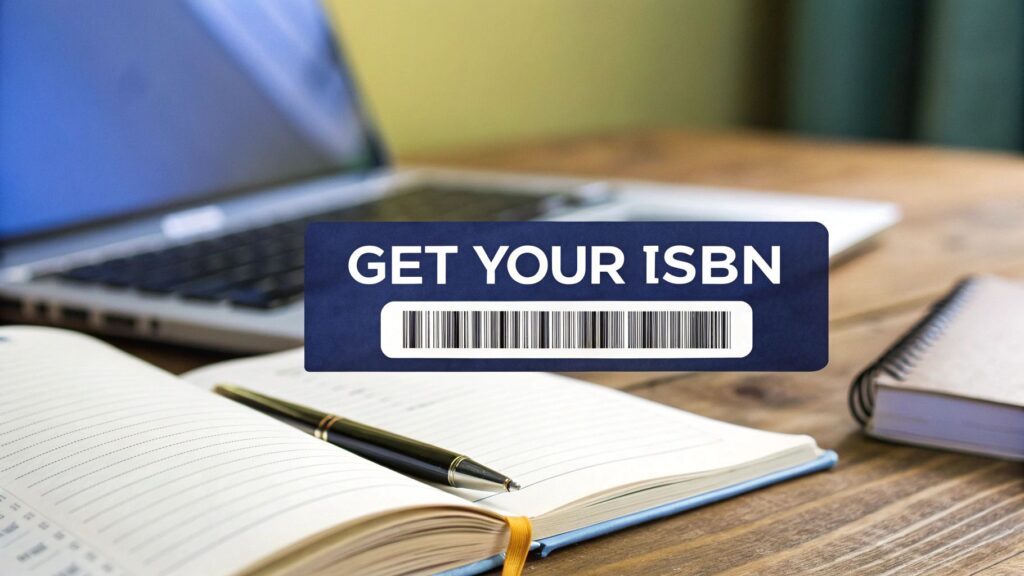Securing an ISBN is one of those non-negotiable first steps for any author aiming to sell their book, whether in brick-and-mortar stores, online, or through libraries. The most direct path is to buy one from the official ISBN agency for your country. For authors in the US, that's Bowker. Alternatively, some publishing platforms offer them, but going directly to the source ensures you are listed as the publisher of record—a critical distinction.
Your Guide to Getting an ISBN
Think of an ISBN as your book’s fingerprint. It's a unique identifier that allows your work to be tracked, ordered, and sold across the globe. Without one, your book is essentially invisible to the entire retail and library ecosystem. It's a process that can seem a bit bureaucratic, but I'll walk you through it so you know exactly what to expect and can sidestep common mistakes.
My goal here is to make this straightforward. Getting your ISBN boils down to three key moves:
- Pinpointing your country's official ISBN provider.
- Figuring out how many ISBNs you actually need (it might be more than one!).
- Assigning the number and all its metadata correctly to your book.
Start at the Source: The International ISBN Agency
While the process has slight variations from country to country, the core principle is the same: publishers (including self-publishers) must get their ISBNs from a single, designated national agency. This agency is part of the global network managed by the International ISBN Agency.
Remember, you'll need a different ISBN for each format of your book. Your paperback needs one, the hardcover needs another, and your EPUB file needs its own. It's all about tracking each unique product.
The most important thing you can do is start your search at the official International ISBN Agency website. This is the only way to guarantee you're dealing with the legitimate source for your country and not a reseller.
I've seen authors get tripped up by third-party sites, which can cause major headaches down the road. The real agency ensures you are listed as the publisher, giving you full control. The screenshot below shows the homepage of the international site—this is your starting point.
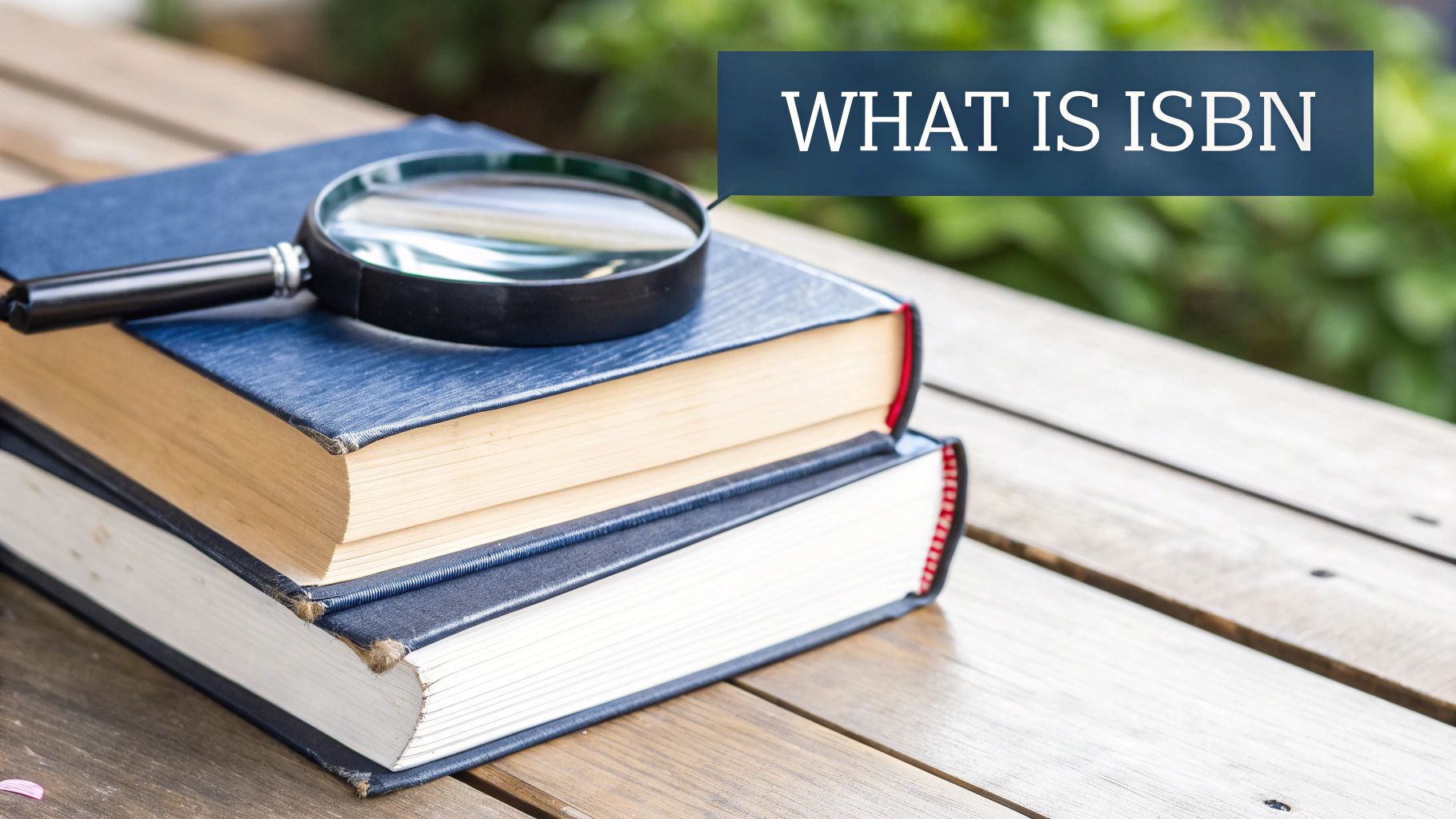
From there, you can use their directory to find the specific organization that handles ISBNs for your region. This single step prevents you from accidentally using a questionable reseller. For a deeper dive into this, our guide on how to get an ISBN for my book breaks it down even further. Taking this official route from the get-go solidifies your ownership and control over your book’s metadata and future.
ISBN Quick Start Checklist
To make it even simpler, here’s a quick-glance table of the essential actions you need to take. Think of this as your roadmap to getting your book officially registered and ready for sale.
| Action Item | Why It Matters for Your Book |
|---|---|
| Locate Your National ISBN Agency | This is the only official source. It ensures you are the publisher of record and have full control over your book's data. |
| Decide How Many ISBNs to Buy | You need a unique ISBN for each format (paperback, hardcover, EPUB, etc.). Buying in bulk (10 or 100) is more cost-effective. |
| Complete the Purchase & Registration | You'll provide publisher and contact information. This step officially logs you into the system. |
| Assign the ISBN to Your Title | Once you have your number, you must log into your agency's portal (like Bowker) and assign all the book's metadata to it. |
Following these steps ensures that when a bookstore, library, or online retailer looks up your ISBN, they find your book, with your name as the publisher. It’s a foundational piece of the publishing puzzle that gives your work legitimacy in the marketplace.
Finding Your Official ISBN Agency
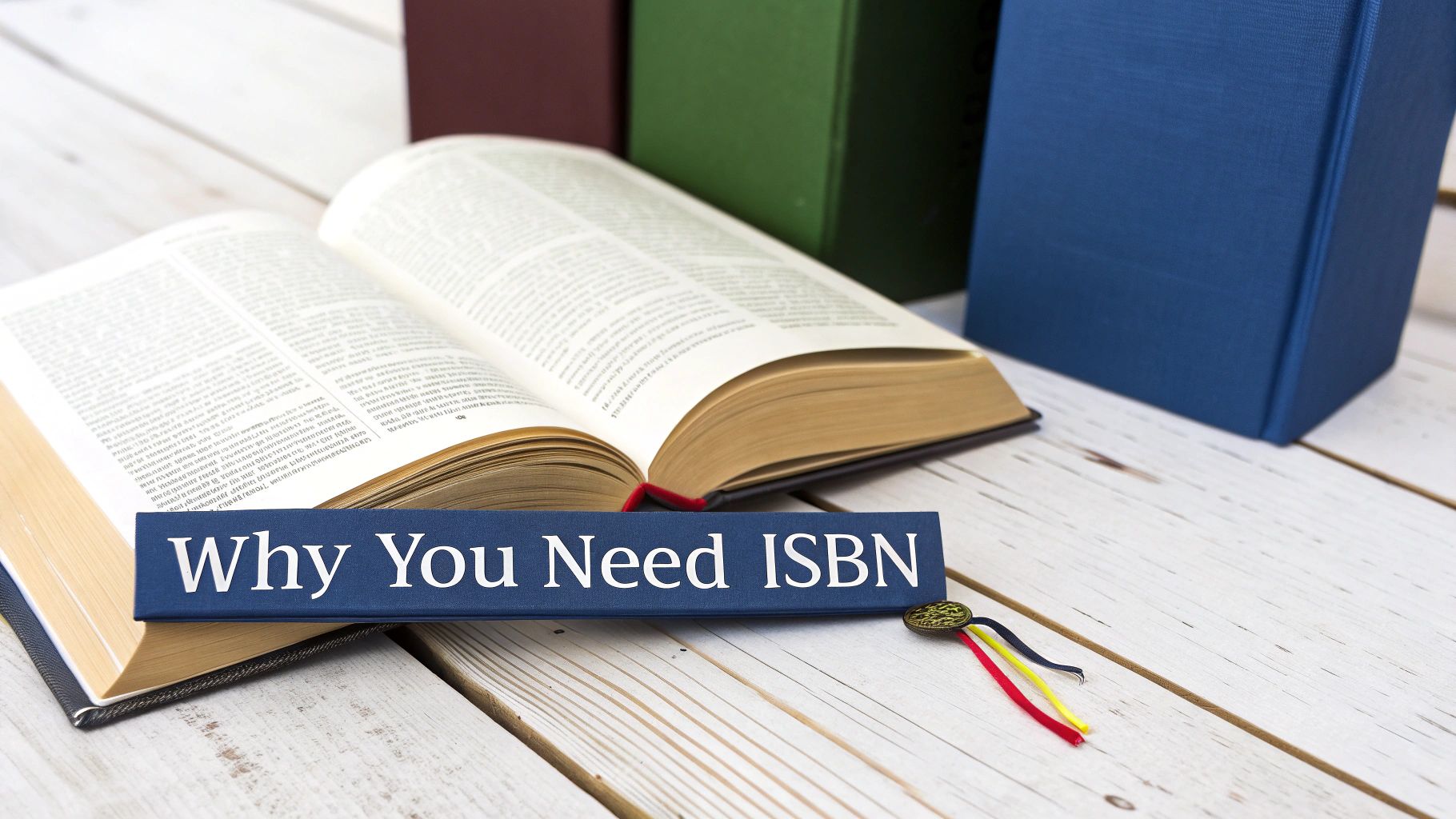
Alright, let's get straight to the most critical step: finding the right place to get your ISBN. This isn't something you want to guess at. The global ISBN system is a network of national agencies, and you absolutely must work with the one assigned to your specific country.
I’ve seen authors get tripped up here by using third-party resellers or free ISBNs, and it can create a real mess with ownership down the road. Think of it like getting a driver's license. You have to go to the official government office, not just some guy who says he can print one for you. Same principle applies.
Locating Your Country's ISBN Provider
So, where do you find this official source? Thankfully, there’s a single, definitive place to look. The International ISBN Agency maintains a master list of every national agency on the planet. Start there, and you can’t go wrong.
Just head to their website and look for the "Find an agency" or "National Agencies" directory. From there, you can select your country from a dropdown list, and it will give you the name, website, and contact information for your designated provider.
This one simple search is your best defense against predatory or illegitimate sellers. For example, if you're in the United States, you’ll be sent to Bowker. Authors in the United Kingdom will find themselves at Nielsen. And for my Canadian friends, you're in luck—Library and Archives Canada handles ISBNs, and they provide them at no cost.
Every country has its own process, which is exactly why using that central directory is a non-negotiable first step.
The real reason this matters so much is that buying directly from your national agency makes you the registrant of record. This is the key that legally establishes you as the publisher, giving you total control over your book's data and how it’s sold.
When you use a "free" ISBN from a printing service or a cheap one from a reseller, they often list themselves as the publisher. That might not sound like a big deal, but it has massive implications for your author career.
Why Direct Purchase Protects Your Author Career
Think of buying your own ISBN as a fundamental investment in your publishing business. It solidifies your independence and makes you look like the professional you are. When you’re listed as the publisher, you call the shots.
This control means you can:
- Work with any printer or distributor you want, now and in the future.
- Ensure your book’s metadata (title, author, description) is accurate everywhere.
- Build a consistent brand by having the same publisher name across all your books.
Let’s play out a common scenario. You publish your first book using a free ISBN from an aggregator. It works out fine. But a year later, you write a second book and find a much better printer or distributor you want to use. The problem? That first ISBN is tied to the original company.
You’re now stuck with two books by the same author listing two different publishers. It looks messy and unprofessional to booksellers and can seriously undermine your author brand.
By taking a few minutes to find your official agency and purchase your own ISBN, you completely avoid these headaches. You secure your ownership, protect your brand, and build a solid foundation for long-term success. It’s the first professional step on your publishing journey.
Paying For and Applying For Your ISBN
Alright, you've found your country's official ISBN agency. Now for the practical part: paying for and applying for your numbers. This is the moment you officially lock in the unique identifiers for your book, and it's a lot simpler than it sounds. The main thing to wrap your head around is the different purchasing options. Getting this right can save you a surprising amount of money.
Most national agencies, like Bowker here in the U.S., don't just sell single ISBNs. They offer bundles, and buying in bulk is where you’ll find the real savings.
This is a bigger deal than it might seem at first. Why? Because you need a separate ISBN for every single format of your book. Your paperback is one product. Your hardcover is another. Your EPUB and your audiobook? Yep, they each need their own unique ISBN. As you can see, the need for multiple ISBNs adds up fast, making a one-off purchase a poor long-term strategy.
Choosing the Right ISBN Package
For the vast majority of indie authors I've worked with, a block of 10 ISBNs is the perfect starting point. It gives you more than enough numbers to handle multiple formats for your first book or two, and the cost-per-ISBN is dramatically lower.
Let's look at the numbers from Bowker to see what I mean. A single ISBN will set you back $125. But a block of 10 costs just $295. That drops the price per ISBN down to $29.50, which is a staggering savings of nearly 77%.
There are larger packages, of course. A block of 100 ISBNs offers an even better unit price, but that's usually overkill unless you're planning a massive series or starting your own small press. My advice? Think about your realistic publishing goals for the next couple of years. If you know you have more books in you, the 10-pack is a smart, flexible investment.
Buying a block of ISBNs is more than just a purchase; it's a strategic move. You're setting yourself up for future formats and books, all while maintaining a consistent publisher identity. It saves you from the headache and expense of making multiple, smaller purchases down the road.
The infographic below gives you a bird's-eye view of the application flow with your agency.
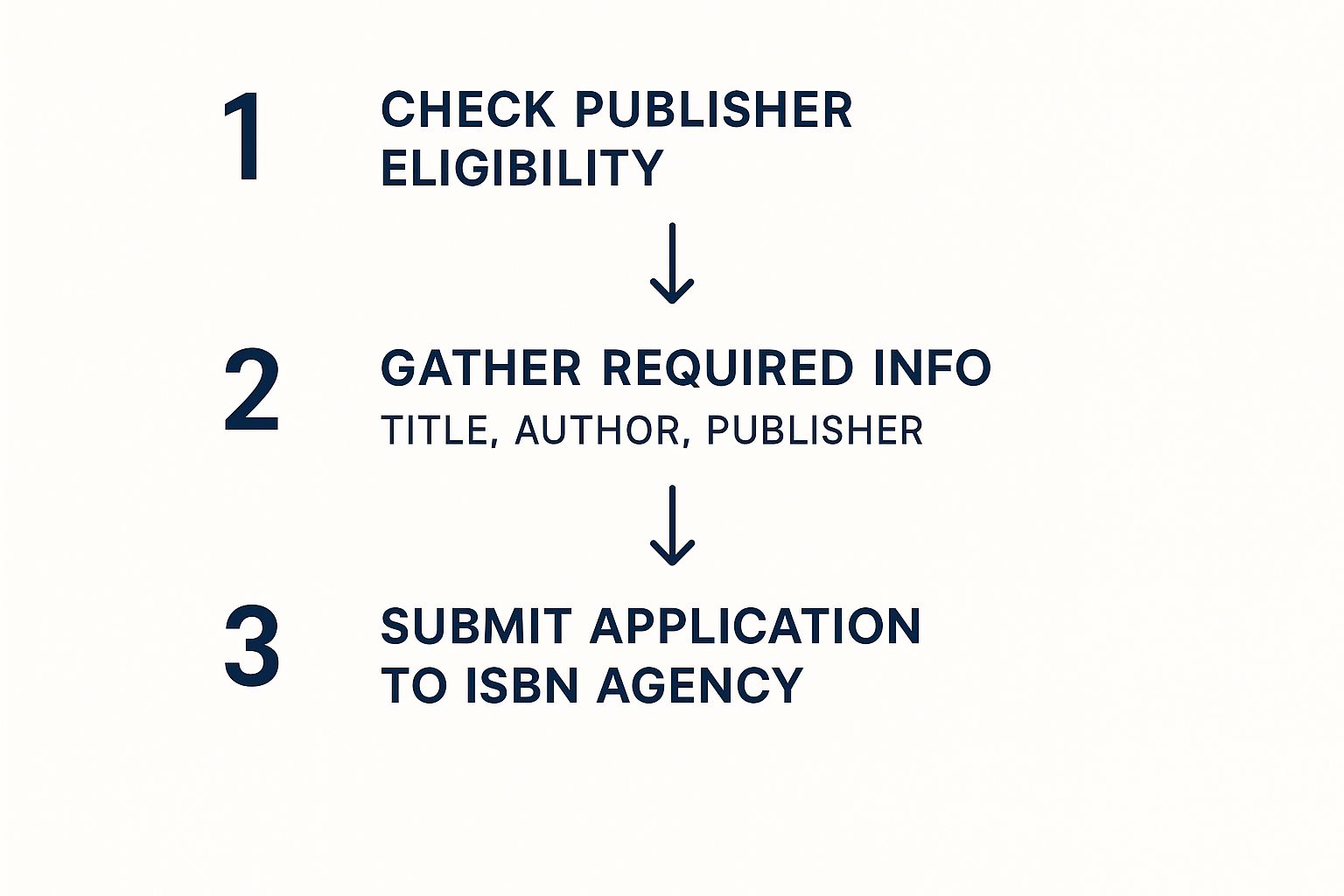
Following this process is what officially registers you as the publisher of record for your book.
Completing the Application and Payment
Once you've picked your package, you’ll move on to the application. This is where you’ll enter your "publisher" details. Don't let the term intimidate you—if you're self-publishing, you are the publisher. You'll just need to provide some basic information:
- Publisher Name: This can be your legal name ("Jane Doe") or an imprint you've created ("Mountain Peak Press"). Using an imprint can look a bit more professional, but your own name works just fine.
- Contact Information: Your address, email, and phone number. This is purely for the agency's administrative records and is tied to your ISBN account.
After you've filled everything out and paid, your ISBNs are usually assigned to your account almost instantly. If you're in the U.S., they’ll pop up in your MyIdentifiers.com dashboard, ready for you to assign to your book's different formats. While getting the numbers is quick, it's still a crucial step you need to account for in your publishing timeline. If you're mapping everything out, our guide on how long it does take to publish a book can help put it all in perspective.
This transaction is what solidifies your role as the publisher. It gives you full control over your book's metadata and distribution, cementing your ownership and professional standing in the publishing world.
What Your 13-Digit ISBN Actually Means
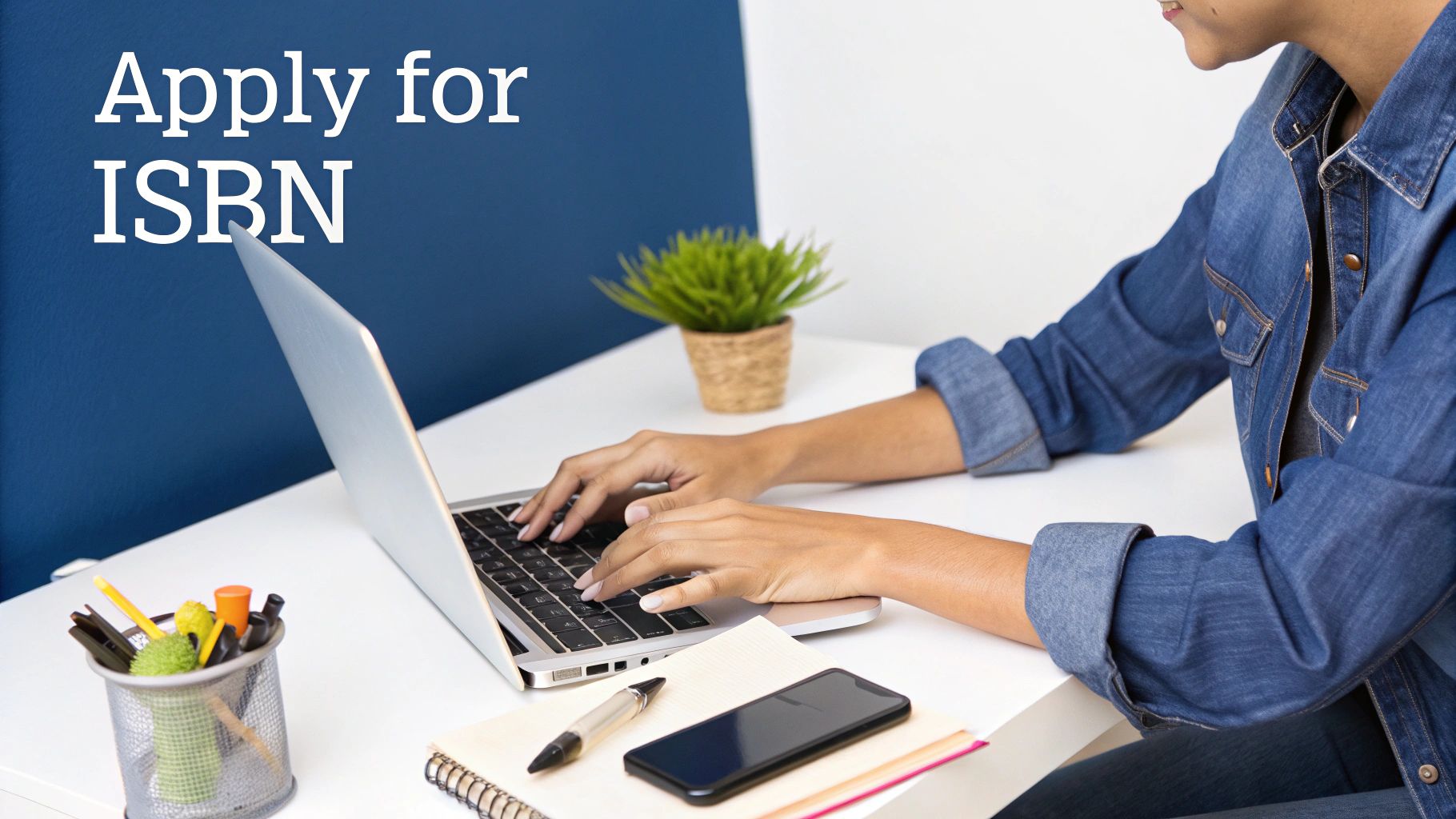
So, you've got your ISBN. It might just look like a long string of numbers, but it’s actually your book’s unique fingerprint in the global marketplace. Think of it less as a random code and more as a highly organized piece of data that tells everyone—from distributors to bookstores—exactly what your product is.
This structure is what prevents a bookstore in London from accidentally ordering your ebook when they wanted the paperback. It’s all about precision. The system we use today, the 13-digit ISBN, was fully rolled out in 2007 to replace the older 10-digit format. This change brought books in line with other retail products and dramatically expanded the number of unique identifiers available.
Cracking the Code: The Five Parts of Your ISBN
Every part of that 13-digit number has a job. The hyphens might shift depending on the publisher's block of numbers, but the five distinct elements are always there, working together to create a unique profile for one specific version of your book.
The first three digits are almost always 978 or 979, marking it as a book product. Next, a group identifier points to the country or language area, like '1' for English-speaking regions or '2' for French. Then you have the registrant (that’s you or your publisher!), the specific publication, and finally, a single check digit. You can dig into the specifics of how number ranges are assigned on freeisbn.com.
Here's a quick breakdown of how those five parts function:
- Prefix Element: The first three digits, either 978 or 979. This simply tells the global EAN (International Article Number) system that this product is a book. Simple as that.
- Registration Group: This block identifies the country or language group. For instance, the number '1' is used for English-speaking areas like the US, UK, and Australia.
- Registrant Element: This is your unique identifier as the publisher. When you buy ISBNs from an agency like Bowker, they assign you a registrant number that belongs exclusively to you or your publishing name.
- Publication Element: This identifies the specific title and, crucially, the format. This is the very reason your paperback, hardcover, and audiobook each need a separate ISBN.
- Check Digit: The final digit is a clever little fail-safe. It's calculated using a specific formula based on the preceding 12 digits. Its only job is to validate the number and catch any typos during ordering or inventory scanning.
Understanding this structure isn't just trivia; it's fundamental to using your ISBNs correctly. It’s how you claim your book's specific spot in the publishing world and ensure your work is tracked accurately from your desk to a reader's hands.
How to Assign and Use Your ISBN Correctly
Getting your ISBN is a huge step, but it's only half the battle. Now you have to actually use it. This is the part where you officially link that unique 13-digit number to your book, giving it a real identity in the global marketplace.
Typically, you'll do this through the online portal of the agency you bought the ISBN from. If you're in the U.S., for instance, you'll be logging into your Bowker MyIdentifiers account to get started.
Once you're in, the system will guide you to assign one of your purchased numbers. This is where you'll enter your book's metadata—the DNA of your book. This isn't just busywork; this data is what populates the search systems used by every single bookseller, library, and distributor on the planet. Think of it as your book's digital birth certificate.
Getting Your Book's Metadata Right
I can't stress this enough: accuracy here is everything. A simple typo in your title or getting an author's name wrong can spiral into a massive headache that's incredibly difficult to fix later. The information you input here goes out to databases all over the world.
So, take a deep breath and double-check every single field. Pay special attention to these:
- Final Title and Subtitle: Is it exactly what's on your cover? No variations.
- Contributors: List every author, editor, and illustrator. Make sure you spell their names correctly and assign the right role to each.
- Book Description: This is your sales copy! Write something compelling that will make someone want to know more.
- Subject Categories: Pick the most relevant BISAC codes. This is how physical and online stores know where to "shelve" your book so the right readers can find it.
Good metadata tells retailers where your book belongs, but more importantly, it helps your future fans discover it. Getting this right from the very beginning is one of the most professional things you can do as a publisher.
Your ISBN metadata is more than just administrative data—it’s one of your most powerful marketing tools. It's what allows a reader searching for a specific topic to find your book. Every field you fill out correctly makes your book more discoverable.
With your ISBN assigned and your metadata locked in, you're ready to get your book out there. This solid foundation is crucial before you start exploring the best places to sell ebooks.
Where to Put the ISBN on Your Actual Book
Alright, the digital side is done. The last step is to make sure the number appears in the right places on your physical book and in your ebook files. The entire publishing industry runs on this standard, so it's not something you can skip.
For any print book, whether it's a paperback or a hardcover, your ISBN has two mandatory homes.
- The Copyright Page: Your ISBN must be clearly printed on the copyright page, which you'll find within the first few pages of the book. The standard format looks like this:
ISBN 978-X-XXX-XXXXX-X. - The Back Cover Barcode: The number also has to be turned into a scannable EAN barcode. This gets placed on the lower part of your back cover, making it easy for stores to scan at the checkout.
For an ebook, the ISBN should be embedded in the file's metadata and also listed on the digital copyright page, just like in a print book.
Ever wonder why we use a 13-digit number? The switch from 10 to 13 digits happened globally on January 1, 2007. This change dramatically increased the number of available ISBNs and aligned the system with the international EAN barcode standard. It was a critical move for huge markets like the US, UK, China, and Germany, which publish millions of titles every year.
By assigning and displaying your number correctly, you’ve officially put your ISBN to work. You're now one step closer to seeing your book in the hands of readers.
Common ISBN Questions Answered
Diving into the world of ISBNs can feel a bit like learning a new language. I get it. New authors, especially, have a ton of questions. Let's walk through some of the most common ones I hear, so you can move forward with confidence. Getting these details right is a huge part of learning how to get an ISBN for a book the proper way.
One of the first hurdles authors run into is figuring out how ISBNs work with different book formats. It's probably the question I get asked most often.
Do You Need Separate ISBNs for Ebooks and Paperbacks?
Yes, absolutely. Every single format of your book needs its own unique ISBN.
Think of it this way: your paperback, hardcover, audiobook, and ebook are all distinct products. A bookstore or online retailer needs a different product number for each one to manage their inventory and track sales.
So, if you plan to release a paperback and an EPUB version for e-readers, you'll need to assign two separate ISBNs. This isn't just a suggestion; it's a hard-and-fast rule of the publishing world that keeps everything running smoothly.
Another big question mark for many authors is the allure of "free" ISBNs from platforms like Amazon's Kindle Direct Publishing (KDP). It sounds like a great deal, but there's a serious catch you need to know about.
Using a free ISBN from a platform like KDP means they, not you, are listed as the publisher of record. This decision can seriously limit your book's future, tying it exclusively to their sales channels and preventing wider distribution.
When you take that free ISBN, you're essentially tethering your book to that platform. You can't take the ISBN Amazon gives you and use it to print copies with IngramSpark or sell it directly to Barnes & Noble.
Buying your own ISBN from your country's official agency is different. It makes you the publisher. This gives you total control and the freedom to distribute your book anywhere and everywhere, now and in the future. For any author serious about their career, it's a non-negotiable first step.
What If You Make Major Changes to Your Book?
This is a great question, and one that comes up often when authors want to release a second edition. The rule of thumb is that if you make substantial changes to an already-published book, you must assign a brand-new ISBN.
So what counts as a "substantial" change? The industry generally agrees on these:
- Adding or removing entire chapters or significant sections of text.
- A major rewrite of the book's content.
- Changing the book's title or subtitle.
On the other hand, simple fixes like correcting typos, updating a few sentences, or making minor formatting tweaks do not require a new ISBN. The new number is a signal to the entire supply chain—from distributors to libraries—that this is a new, revised, and distinct edition of your work.
At BarkerBooks, we guide authors through every step of the publishing journey, including ISBN registration and metadata management. Ready to turn your manuscript into a professionally published book? Explore our publishing packages today
